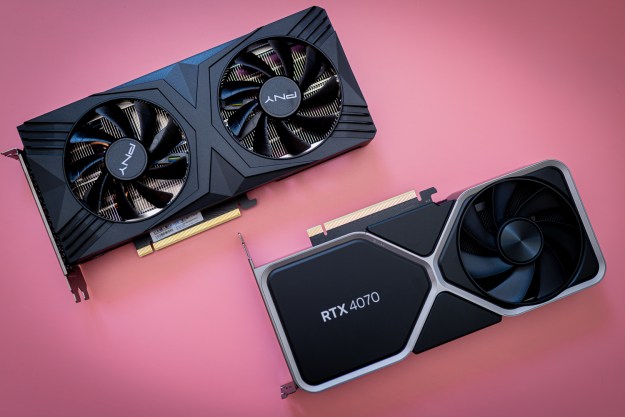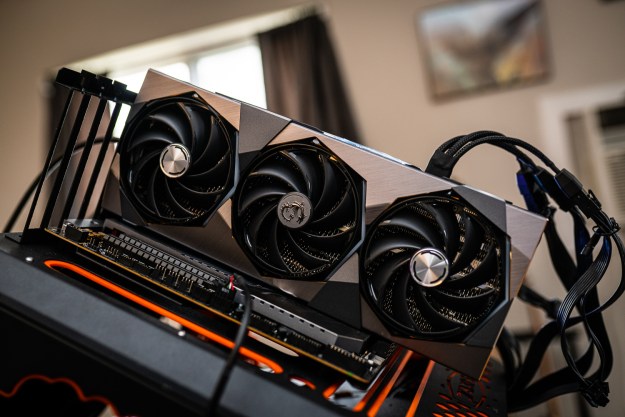Nvidia certainly heated up the GPU market with the introduction of its GeForce GTX 1080 “Pascal” graphics chip earlier this month. It’s the company’s fastest processor yet, and we’re now seeing Nvidia partners rolling out their GTX 1080-based solutions alongside the official launch, including long-time GPU collaborator Asus. The company launched its Republic of Gamers Strix GeForce GTX 1080 card on Friday that’s up for grabs now, and will be showcased during Computex 2016 next week.
The Strix GeForce GTX 1080 is actually served up by Asus in two tasty flavors: the Strix-GTX1080-O8G-Gaming card and the Strix-GTX1080-8G-Gaming card. Both cards have a base clock of 1,607MHz, 8GB of GDDR5X memory, a 256-bit memory interface, one DVI-D output, two HDMI 2.0 outputs, and two DisplayPort 1.4 outputs. PCI Express 3.0 and OpenGL 4.5 are also supported by both.
However, what sets these two cards apart is their boost speeds. The Strix GTX1080 8G gaming card has a single boost clock of 1,733MHz. The Strix GTX1080 O8G gaming card, on the other hand, has two boost clock speeds: a 1,898MHz speed in Game Mode and an even higher 1,936MHz in OC mode. Talk about turning up the heat!
That said, these cards need a reliable cooling system to keep the speedy Pascal chips from overheating, and that’s where the Asus DirectCU III cooling system comes in. This platform uses “direct-GPU-contact” heatpipes that not only pull heat away from the graphics chips through surface transference, but promise up to 30-percent cooler gaming performance when compared to reference design setups.
Joining these heatpipes are three 0dB fans that sport a patented wing-blade design that the company says makes them three times quieter than reference design fans. These fans are backed by the company’s FanConnect technology, which includes two 4-pin GPU-controlled headers for connecting system fans. That way, the graphics cards can borrow the PC’s fans in case the system needs additional help in staying cool. Neat.
“All Asus graphics cards are now produced using Auto-Extreme technology, an industry-exclusive, 100-percent automated production process that incorporates premium materials to set a new standard of quality,” the company said on Friday. “Auto-Extreme technology ensures consistent graphics card quality as well as improved performance and longevity. This new manufacturing process is also environmentally friendly, eliminating harsh chemicals and reducing power consumption by 50 percent.”
Other ingredients thrown into the new Asus cards include Super Alloy Power II components, the company’s Aura RGB Lighting system on both the shroud and backplate, and as listed earlier, a VR-friendly design thanks to two HDMI ports. That means customers can plug their favorite VR headset into one port and a monitor into the other port, preventing the need to swap cables between the external devices.
In addition to the cards themselves, Asus is bundling the hardware with GPU Tweak II to optimize system performance for smoother gameplay, and for overclocking the graphics chip. The cards also come packed with a one-year subscription to XSplit Gamecaster premium, which would otherwise cost an added $99. This software includes an in-game overlay that displays the GPU clock speed, VRM usage, and temperature. The overlay even provides controls for GPU Tweak II.
As previously stated, the two cards are available now across the globe. The Strix GTX1080 O8G gaming card costs $640 and the Strix GTX1080 8G gaming card costs $620. Heck, with those prices in mind, you might as well shell out the extra $20 for the overclocked model! No? Yes? Maybe?
Editors' Recommendations
- Nvidia RTX 50-series graphics cards: news, release date, price, and more
- Asus’ new RTX 4090 shattered GPU overclocking records, and you’ll be able to buy it soon
- Nvidia’s most important next-gen GPU is less than 2 weeks away
- Intel’s upcoming iGPU might destroy both Nvidia and Apple M2
- Nvidia is serving up a major price cut on its best GPU



